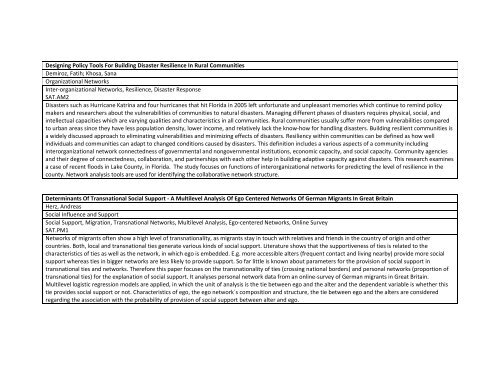Sunbelt XXXI International Network for Social Network ... - INSNA
Sunbelt XXXI International Network for Social Network ... - INSNA
Sunbelt XXXI International Network for Social Network ... - INSNA
You also want an ePaper? Increase the reach of your titles
YUMPU automatically turns print PDFs into web optimized ePapers that Google loves.
Designing Policy Tools For Building Disaster Resilience In Rural CommunitiesDemiroz, Fatih; Khosa, SanaOrganizational <strong>Network</strong>sInter‐organizational <strong>Network</strong>s, Resilience, Disaster ResponseSAT.AM2Disasters such as Hurricane Katrina and four hurricanes that hit Florida in 2005 left un<strong>for</strong>tunate and unpleasant memories which continue to remind policymakers and researchers about the vulnerabilities of communities to natural disasters. Managing different phases of disasters requires physical, social, andintellectual capacities which are varying qualities and characteristics in all communities. Rural communities usually suffer more from vulnerabilities comparedto urban areas since they have less population density, lower income, and relatively lack the know‐how <strong>for</strong> handling disasters. Building resilient communities isa widely discussed approach to eliminating vulnerabilities and minimizing effects of disasters. Resiliency within communities can be defined as how wellindividuals and communities can adapt to changed conditions caused by disasters. This definition includes a various aspects of a community includinginterorganizational network connectedness of governmental and nongovernmental institutions, economic capacity, and social capacity. Community agenciesand their degree of connectedness, collaboration, and partnerships with each other help in building adaptive capacity against disasters. This research examinesa case of recent floods in Lake County, in Florida. The study focuses on functions of interorganizational networks <strong>for</strong> predicting the level of resilience in thecounty. <strong>Network</strong> analysis tools are used <strong>for</strong> identifying the collaborative network structure.Determinants Of Transnational <strong>Social</strong> Support ‐ A Multilevel Analysis Of Ego Centered <strong>Network</strong>s Of German Migrants In Great BritainHerz, Andreas<strong>Social</strong> Influence and Support<strong>Social</strong> Support, Migration, Transnational <strong>Network</strong>s, Multilevel Analysis, Ego‐centered <strong>Network</strong>s, Online SurveySAT.PM1<strong>Network</strong>s of migrants often show a high level of transnationality, as migrants stay in touch with relatives and friends in the country of origin and othercountries. Both, local and transnational ties generate various kinds of social support. Literature shows that the supportiveness of ties is related to thecharacteristics of ties as well as the network, in which ego is embedded. E.g. more accessible alters (frequent contact and living nearby) provide more socialsupport whereas ties in bigger networks are less likely to provide support. So far little is known about parameters <strong>for</strong> the provision of social support intransnational ties and networks. There<strong>for</strong>e this paper focuses on the transnationality of ties (crossing national borders) and personal networks (proportion oftransnational ties) <strong>for</strong> the explanation of social support. It analyses personal network data from an online‐survey of German migrants in Great Britain.Multilevel logistic regression models are applied, in which the unit of analysis is the tie between ego and the alter and the dependent variable is whether thistie provides social support or not. Characteristics of ego, the ego network´s composition and structure, the tie between ego and the alters are consideredregarding the association with the probability of provision of social support between alter and ego.
















